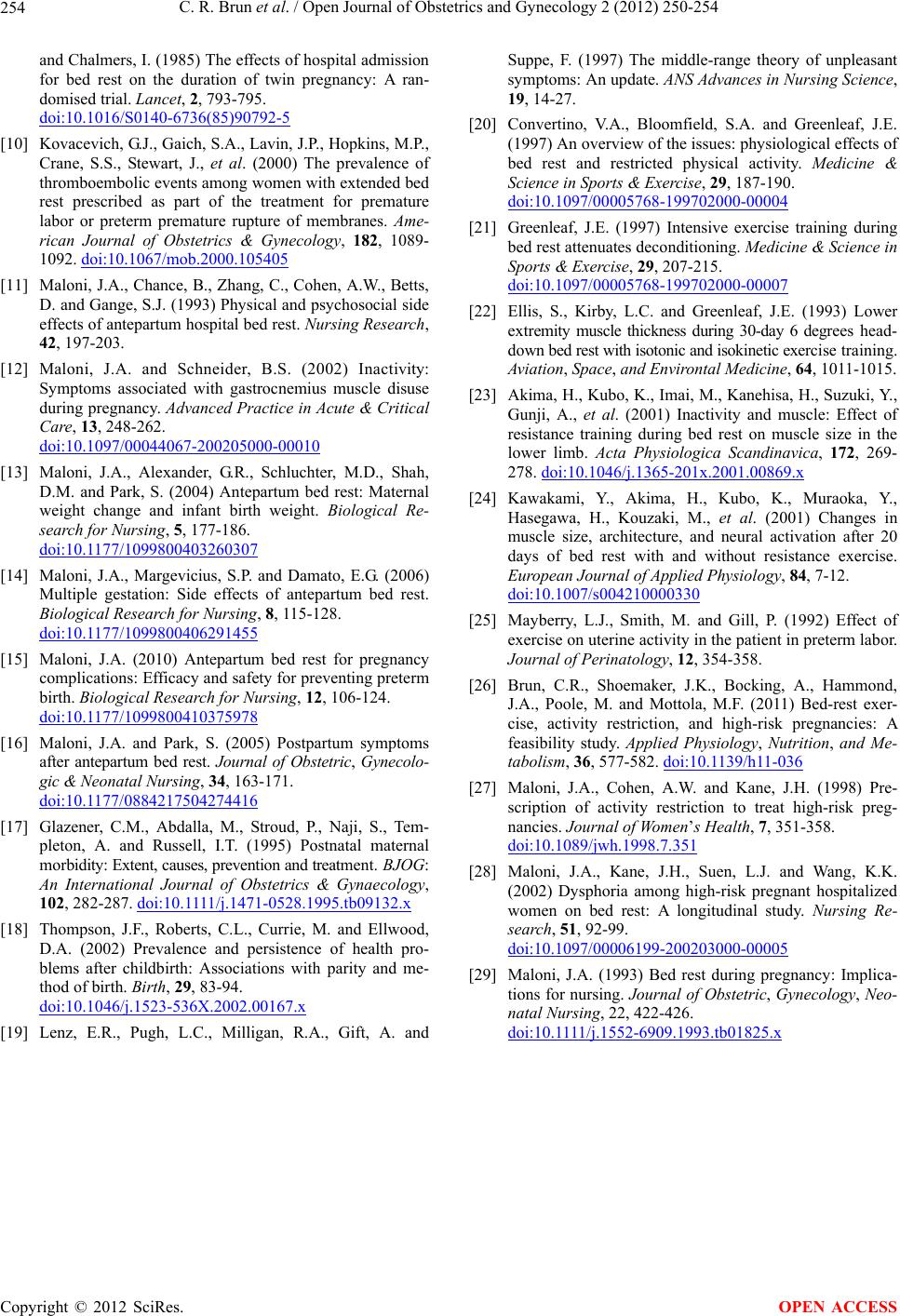
C. R. Brun et al. / Open Journal of Obstetrics and Gynecology 2 (2012) 250-254
Copyright © 2012 SciRes.
254
OPEN ACCESS
and Chalmers, I. (1985) The effects of hospital admission
for bed rest on the duration of twin pregnancy: A ran-
domised trial. Lancet, 2, 793-795.
doi:10.1016/S0140-6736(85)90792-5
[10] Kovacevich, G.J., Gaich, S.A., Lavin, J.P., Hopkins, M.P.,
Crane, S.S., Stewart, J., et al. (2000) The prevalence of
thromboembolic events among women with extended bed
rest prescribed as part of the treatment for premature
labor or preterm premature rupture of membranes. Ame-
rican Journal of Obstetrics & Gynecology, 182, 1089-
1092. doi:10.1067/mob.2000.105405
[11] Maloni, J.A., Chance, B., Zhang, C., Cohen, A.W., Betts,
D. and Gange, S.J. (1993) Physical and psychosocial side
effects of antepartum hospital bed rest. Nursing Research,
42, 197-203.
[12] Maloni, J.A. and Schneider, B.S. (2002) Inactivity:
Symptoms associated with gastrocnemius muscle disuse
during pregnancy. Advanced Practice in Acute & Critical
Care, 13, 248-262.
doi:10.1097/00044067-200205000-00010
[13] Maloni, J.A., Alexander, G.R., Schluchter, M.D., Shah,
D.M. and Park, S. (2004) Antepartum bed rest: Maternal
weight change and infant birth weight. Biological Re-
search for Nursing, 5, 177-186.
doi:10.1177/1099800403260307
[14] Maloni, J.A., Margevicius, S.P. and Damato, E.G. (2006)
Multiple gestation: Side effects of antepartum bed rest.
Biological Research for Nursing, 8, 115-128.
doi:10.1177/1099800406291455
[15] Maloni, J.A. (2010) Antepartum bed rest for pregnancy
complications: Efficacy and safety for preventing preterm
birth. Biological Research for Nursing, 12, 106-124.
doi:10.1177/1099800410375978
[16] Maloni, J.A. and Park, S. (2005) Postpartum symptoms
after antepartum bed rest. Journal of Obstetric, Gynecolo-
gic & Neonatal Nursing, 34, 163-171.
doi:10.1177/0884217504274416
[17] Glazener, C.M., Abdalla, M., Stroud, P., Naji, S., Tem-
pleton, A. and Russell, I.T. (1995) Postnatal maternal
mo rbidity: Extent, causes, prevention and treatmen t . BJOG:
An International Journal of Obstetrics & Gynaecology,
102, 282-287. d oi: 10. 1111/j .14 71- 0528.1995.tb09132.x
[18] Thompson, J.F., Roberts, C.L., Currie, M. and Ellwood,
D.A. (2002) Prevalence and persistence of health pro-
blems after childbirth: Associations with parity and me-
thod of birth. Birth, 29, 83-94.
doi:10.1046/j.1523-536X.2002.00167.x
[19] Lenz, E.R., Pugh, L.C., Milligan, R.A., Gift, A. and
Suppe, F. (1997) The middle-range theory of unpleasant
symptoms: An update. ANS Advances in Nursing Science,
19, 14-27.
[20] Convertino, V.A., Bloomfield, S.A. and Greenleaf, J.E.
(1997) An overview of the issues: physiological effects of
bed rest and restricted physical activity. Medicine &
Science in Sports & Exercise, 29, 187-190.
doi:10.1097/00005768-199702000-00004
[21] Greenleaf, J.E. (1997) Intensive exercise training during
bed rest attenuates deconditioning. Medicin e & Science in
Sports & Exercise, 29, 207-215.
doi:10.1097/00005768-199702000-00007
[22] Ellis, S., Kirby, L.C. and Greenleaf, J.E. (1993) Lower
extremity muscle thickness during 30-day 6 degrees head-
down bed rest with isotonic and isokinetic exerci se trainin g.
Aviation, Space, and Environtal Medicine, 64, 1011-1015.
[23] Akima, H., Kubo, K., Imai, M., Kanehisa, H., Suzuki, Y.,
Gunji, A., et al. (2001) Inactivity and muscle: Effect of
resistance training during bed rest on muscle size in the
lower limb. Acta Physiologica Scandinavica, 172, 269-
278. doi:10.1046/j.1365-201x.2001.00869.x
[24] Kawakami, Y., Akima, H., Kubo, K., Muraoka, Y.,
Hasegawa, H., Kouzaki, M., et al. (2001) Changes in
muscle size, architecture, and neural activation after 20
days of bed rest with and without resistance exercise.
European Journal of Applied Physiology, 84, 7-12.
doi:10.1007/s004210000330
[25] Mayberry, L.J., Smith, M. and Gill, P. (1992) Effect of
exercise on uterine activity in the patient in preterm labor.
Journal of Perinatology, 12, 354-358.
[26] Brun, C.R., Shoemaker, J.K., Bocking, A., Hammond,
J.A., Poole, M. and Mottola, M.F. (2011) Bed-rest exer-
cise, activity restriction, and high-risk pregnancies: A
feasibility study. Applied Physiology, Nutrition, and Me-
tabolism, 36, 577-582. doi:10.1139/h11-036
[27] Maloni, J.A., Cohen, A.W. and Kane, J.H. (1998) Pre-
scription of activity restriction to treat high-risk preg-
nancies. Journal of Women’s Health, 7, 351-358.
doi:10.1089/jwh.1998.7.351
[28] Maloni, J.A., Kane, J.H., Suen, L.J. and Wang, K.K.
(2002) Dysphoria among high-risk pregnant hospitalized
women on bed rest: A longitudinal study. Nursing Re-
search, 51, 92-99.
doi:10.1097/00006199-200203000-00005
[29] Maloni, J.A. (1993) Bed rest during pregnancy: Implica-
tions for nursing. Journal of Obstetric, Gynecology, Neo-
natal Nursing, 22, 422-426.
d oi: 10. 1111/j .15 52- 6909.1993.tb01825.x